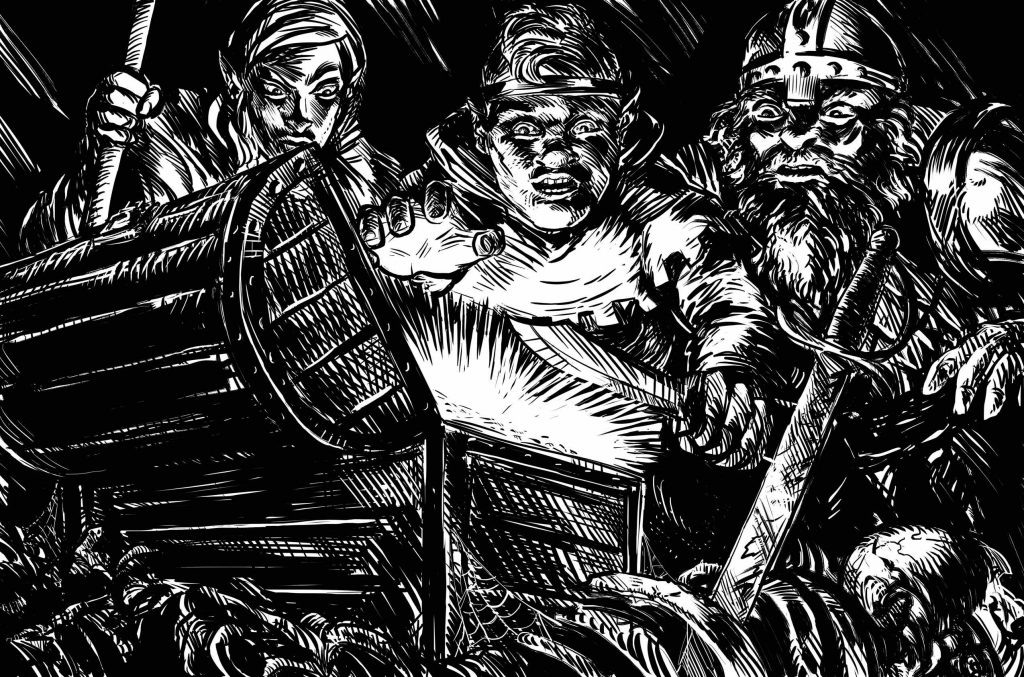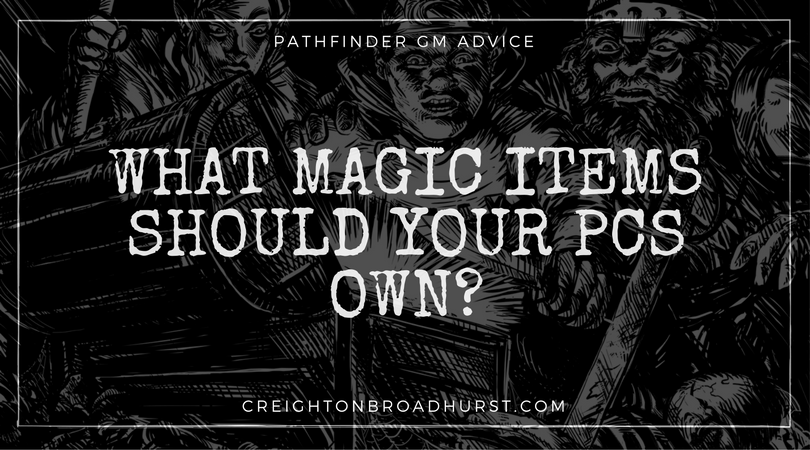I’ve recently done some research on character wealth and treasure values in Pathfinder. (The long winter nights just fly by here at Raging Swan Press Global HQ). While this might not sound too fascinating a subject, it’s thrown up—for me—some interesting facts and questions.

Treasure values and character wealth are two subjects that don’t seem to get a lot of attention in commercially produced adventures. It seems to me, us designers spend much more time focusing on CRs and XP. Treasure is an after thought. That’s odd given how much players obsess over and covet it!
For example, a quick audit reveals in my Shattered Star campaign the heroes are all worth much more than they “should” be worth at their level. Some are almost twice as wealthy as they “should” be. They’ve also acquired some pretty powerful individual items—beyond the objects of their quest—which I wouldn’t normally expect to be possessed by such relatively inexperienced adventurers. In turn, this obviously affects how effective they are in many situations.
This realisation has—in turn—made me more determined to follow the treasure guidelines for encounters when designing Gloamhold. (I’ll be running it using Pathfinder, of course!) This is particularly important as I plan to use the slow advancement track (which I love) because it requires the PCs to win through more encounters to reach any given level. (With more encounters, there are more opportunities to provide inappropriate treasure!)
I’ve blogged repeatedly about our obsession with balance, CRs and appropriate encounters, but I haven’t really touched on treasure—and by extension a PC’s wealth—before. After all, no matter how the GM views balance, it’s surely a good idea the PCs’ loot is commensurate with the foes they defeat.
Treasure is an incredibly important aspects of the game. If the PCs possesses items too powerful (read unbalanced) for their level, play can suffer as a result. Similarly, if the PCs are under-equipped they could be in for some hard times. According to the Pathfinder Core Rulebook:
“As a general rule, PCs should not own any magic item worth more than half their total character wealth…”
This got me thinking. What items did the game’s designers assume PCs would have at various levels? I mean they clearly put some thought into the matter.
Thus here—accordingly to my back-of-a-napkin calculations—are basic lists of what GMs and module designers should assume PCs might possess at certain levels.
This is useful information.
Knowing what resources the PCs can likely employ helps the diligent designer create exciting challenges. For example, it probably isn’t a good idea to design an encounter for characters below 5th-level featuring creatures with adamantine damage reduction (because the PCs are unlikely to have adamantine weapons). But then again, it might be a good plan depending on the dungeon set up, style of play, purpose of the encounter and so on. In any event, forewarned is forearmed.
So, here are the lists:
2nd-Level
At 2nd-level, a character is worth roughly 1,000 gp and can own:
- Any masterwork armour except half-plate or full plate.
- Any masterwork weapon.
- Magical ammunition for missile weapons.
- Virtually any 1st-, or 2nd-level potion.
- Virtually any 1st-5th-level scroll.
- Cheap (mostly consumable) minor wondrous items.
- A fully charged 0-level wand, excepting those containing spells with expensive material components.
3rd-Level
Character’s wealth is worth roughly 3,000 gp and can own:
- Any masterwork armour except full plate.
- Light mithral armour, mithral shield or light mithral weapon.
- Virtually any 3rd-level potion.
- A fully charged 1st-level wand, excepting those containing spells with expensive material components.
3rd-level throws up an interesting conundrum: mithral is described in the core rulebook as “very rare”; this clearly isn’t the case if 3rd-level characters can afford to buy it!
4th-Level
At 4th-level, a character is worth roughly 6,000 gp and can own:
- +1 armour or +1 shield.
- A permanent—i.e. not ammunition—+1 weapon.
- Cheap minor magic rings.
- Cheap medium magic rods.
- Virtually any 6th- or 8th-level scroll.
- Many minor wondrous item
5th-Level
At 5th-level, a character is worth roughly 10,500 gp and can own:
- +2 armour or +2 shield.
- Medium mithral armour.
- Adamantine weapon.
- The cheapest medium magic ring.
- Virtually any 9th-level scroll.
- A fully charged 2nd-level wand , excepting those containing spells with expensive material components.
In a similar fashion to 3rd-level, 5th-level throws up the question of adamantine’s rarity. It’s described as “mined from rocks that fell from the heavens” in the core rulebook but any adventurer of 5th-level and above can afford an adamantine weapon. Just how many rocks fall from the sky?
6th-Level
At 5th-level, a character is worth roughly 16,000 gp and can own:
- Adamantine light armour.
- A permanent—i.e. not ammunition—+2 weapon.
- Other medium magic rings.
- Any minor wondrous item or the cheapest medium wondrous items.
7th-Level
At 7th-level, a character is worth roughly 23,500 gp and can own:
- +3 armour or +3 shield.
- Heavy mithral armour.
- Adamantine medium armour.
- Cheap major magic rods.
- A fully charged 3rd-level wand, excepting those containing spells with expensive material components.
8th-Level
At 8th-level, a character is worth roughly 33,000 gp and can own:
- Adamantine heavy armour.
- The cheapest major magic rings.
9th-Level
At 9th-level, a character is worth roughly 46,500 gp and can own:
- +4 armour or +4 shield.
- A permanent—i.e. not ammunition—+3 weapon.
- Cheap medium magic staves.
- The cheapest major wondrous item.
- A fully charged 4th-level wand, excepting those containing spells with expensive material components.
10th-Level
At 10th-level, a character is worth roughly 62,000 gp and can own:
- +4 armour or +4 shield.
- Any medium wondrous item or the cheapest major wondrous items.
A Note on Levels
The astute reader will note the lists above only extend to 10th-level. That’s for several reasons:
- I’m not a fan of high-level play (and by high-level I mean anything over the old “name” level).
- My Shattered Star campaign is hovering around 8th-level. When the PCs get closer to 10th-level I might update these lists.
The Final Word
As GMs and designers we spend—I think—an inordinate amount of time crafting (or possibly obsessing over) exciting encounters and unique, challenging NPCs.
We seem to spend much less time thinking about treasure, and that’s not ideal. After all, any given NPC will likely feature in only one encounter before suffering a violent demise. Items of treasure—particularly magic items assuming they are not instantly sold—could be around for much longer. We should, therefore, spend more time thinking about the nature and value of the treasure we place in our dungeons.
What do you think? Let me know, in the comments below.

Fantastic! How would you modify for 5th edition?
I have absolutely no idea! Magic items in 5e don’t seem to have a set value so creating a similar list of items would be tricky I fear!
Thanks!
The “magic item rarity” table on page 135 of the 5E DMG might answer your question.
Wouldn’t the slow advancement track exacerbate the treasure/encounter/level balance?
If 13 encounters generates 4000gp/4 players
Then 26 encounters generates 8000gp/4 players?
Just a thought.
The core rulebook has a table of page 399 that breaks down by party level what each encounter should give in terms of treasure for three different advancement speeds. Slow is substantially less, but not half of the medium advancement track numbers. I guess this is because the PCs will use up more consumables as they go through more encounters!
(Suggested correction: Last sentence of first paragraph, layers should be players, although some Players are like onions stinky , kept in the dark, and growing white hairs to misquote Donkey)
Perhaps it is time to make a spell that summons “rocks to fall from the heavens” in order to have enough Adamantine for your world? The applications of in or out of combat utility would make it interesting at a minimum.
Well spotted. Thank you!
My friends and I always laugh over the idea that the first people walking the plane couldn’t go anywhere without just tripping over diamonds, but then those pesky clerics had to go and ruin everything haha
In my campaigns I have always had a rule that players would gain:
+1 items at 4th level, +2 items at 8th level, +3 items at 12th level, +4 items at 16th level and +5 items at 20th level. Each level would take a minimum of four sessions to play – around 20-24 hours of play per level.
But … I no longer enjoy high level characters and high fantasy style games. So I am planning to change my advancement/allocation track to the following:
+1 items at 3rd level, +2 items at 6th level, +3 items at 9th level I will not be playing beyond 10th level as a group. Each level would take a minimum of four sessions to play – around 20-24 hours of play per level.
I may consider playing to 12th level with individual players with a couple of henchmen to simulate their “name level,” domain/kingdom style of play.
I believe that less is more approach will make players appreciate the items that they have and rely on their abilities and mundane items. As much as I enjoy Pathfinder, I wish there was a Pathfinder LITE, there is just too much bloat. So I am uncertain where that leaves me going forward as I enjoy Pathfinder at its heart, but not all the extra bloat. I am currently looking at a number of OSR rule sets and hope to have clarity in the next couple of weeks. I want a gritty, low fantasy game with slow advancement with character and world development with multiple threads in a open sandbox with an main plot threading itself into multiple story hooks
Personally I feel as a guide this is OK but not realistic. What about “The Sorcerers Apprentice”? where the acolyte got hold of a powerful magical item and lost control of it? I’d prefer to see that happen from time to time than making sure my players ONLY got what they deserved based on a guideline system based on level. I have been playing RPGS since 1980 and been GM’ing my own Chivalry & Sorcery 2nd Edition group since 1983 til the present day. In my group I never control who gets what, I am a tight GM and make it very hard for players to gain magic but when they do get it they revere it and covert it. Telling a player his character will not be getting a certain item until he gains “x” level is just not right. Life is not easy, life is hard and life can give you unexpected breaks when you least expect them so be tight fisted with magic so that when a player gets some they really appreciate it.
Another great article, CB.
I remember in 1E that the most treasured items were boots of striding and springing and rings of free action. Then they made free action a spell and ruined boots of striding and springing in subsequent editions.